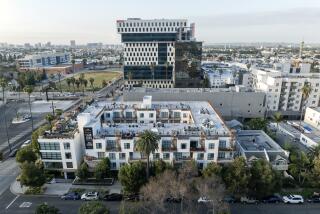Boulevard Plan Throws a Curve Ball : Some people, it seems, have little patience with creative thinking. Some people, it seems, think the glass is half-empty.
The intersection of Ventura and Topanga Canyon boulevards, if not the busiest crossroads in all of Los Angeles, is right up there. Just about everybody thinks there’s too much traffic.
Everybody, that is, except Danny Frydrychowski. But if you owned the Unocal station on this corner, all those cars might look nice to you, too.
Frydrychowski, who lives in Sunland, thinks it’s great that a new Ralphs is going in across the street in the Woodland Hills Center. He wouldn’t mind another fast-food franchise or two.
And he even gives a thumbs up to the architect’s idea of transforming this intersection into a kind of drive-thru baseball diamond, with a 12-foot statue of a Little League pitcher smack dab in the middle and a 12-foot batter at the northeast corner. (Frydrychowski’s station would be just off third base--the hot corner.)
“Anything to dress it up. Like our flowers,” the gas station owner says, proudly pointing to a colorful profusion at the base of a pole topped off with an orange “76” ball. “That was all rocks when we got here.”
It wasn’t scientific, and it wasn’t a big survey, but at least I had managed to find one Woodland Hills merchant who rather likes the first drawings rendered in the city’s 20-year, $222-million scheme to spruce up Ventura Boulevard, starting with Woodland Hills.
A more common sentiment was expressed by a waitress at Solley’s whose name tag identified her as Renee.
“Get outta here,” she said.
Funny how a concept, a drawing on a piece of paper, can serve as a touchstone. The Little League statue could serve as a barometer of Valley values and attitudes.
Greg Nelson, a Tarzana architect who proposed the Little League statuary, says the idea was to celebrate Woodland Hills as a family-oriented community where the needs of children are a top priority. A native of Chicago, he sees Woodland Hills, unlike communities more to the east, as a community that has retained a parklike feel with its large lots and abundant trees.
As Nelson sees it, the expressions of the pitcher and batter would tell a story--the suspense of a well-struck drive, right after the moment of impact.
“I just thought it was time to pay tribute to the kids,” says Nelson, who donated his time and effort to the redesign plans. “All you hear about kids these days are gangs, and it would be nice to emphasize the positive. . . . I live in an area that reminds me of the Timmy and Lassie era, and it would be nice to capture that.”
And Nelson insists that, for all that traffic, the intersection could accommodate the oversized Little Leaguer. “An aerial photograph shows there’s a pocket right in the middle that is never touched.”
Mr. Nelson, meet Mayor Goldwater.
“Come on, now. I don’t see where a statue is going to make any difference,” says Rose Goldwater, proprietor of the Print Shop on Ventura Boulevard. She is Woodland Hills’ honorary mayor, as selected by the local Chamber of Commerce.
“My impression is the money can be put to much better use. We need places for people to park. If you’ve got the money, put a parking lot in. . . . A statue just lends itself to more graffiti, more vandalism. . . . It just doesn’t make sense to me. And I’m not against baseball. Or kids. I love kids.”
And this is Richard Grunnell, manager of the plumbing department at Franklin Hardware: “Do you know how many people are going to drive into that thing?”
And Sang Chun, helping out in his parents’ liquor store: “What the hell are they going to do?”
Some people, it seems, have little patience with creative thinking. Some people, it seems, think the glass is half-empty.
Even Hermalee Schmidt, who represents Woodland Hills on the Ventura Boulevard Specific Plan Review Board, praised the architect’s creativity, but didn’t exactly go to bat for Nelson’s Little League scheme.
“Gosh, that’s just a conception. That’s nothing set in concrete,” Schmidt said. Artwork could be moved to the corner, just to signify that the intersection is a “gateway” to Woodland Hills. The significance of the concept, she said, is to suggest possibilities.
But wouldn’t any artwork become a target for vandals?
“You keep hoping,” Schmidt said with a sigh, “that the world would get to be a better place.”
Which is precisely why Greg Nelson says he came up with the idea in the first place.
Right now, he might feel a little like a pitcher who just hung a curve ball. But it’s early yet. The critics are just starting to take batting practice.
“I have to look at it more optimistically,” Nelson says. “You’ve got to start somewhere in turning people’s attitudes around.”
More to Read
Start your day right
Sign up for Essential California for news, features and recommendations from the L.A. Times and beyond in your inbox six days a week.
You may occasionally receive promotional content from the Los Angeles Times.






